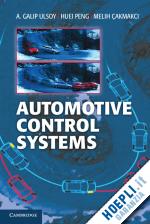A. Galip Ulsoy is the C. D. Mote, Jr Distinguished University Professor, the William Clay Ford Professor of Manufacturing and the Deputy Director of the Ground Robotics Reliability Center and the Engineering Research Center for Reconfigurable Manufacturing Systems. He has been on the faculty of the Department of Mechanical Engineering at the University of Michigan since 1980 and was the founding Director of the Program in Manufacturing. He served as the Technical Editor of the ASME Journal of Dynamic Systems Measurement and Control and the IEEE/ASME Transactions on Mechatronics and is a member of the editorial board of Mechanical Systems and Signal Processing and several other international journals. Ulsoy is a member of the National Academy of Engineering, a Fellow of the American Society of Mechanical Engineers, the International Federation of Automatic Control and the Society of Manufacturing Engineers, a Senior Member of the IEEE, and a member of several other professional and honorary organizations. He is the past President of the American Automatic Control Council. He is the co-author, with Warren R. DeVries, of Microcomputer Applications in Manufacturing and a co-author of Time Delay Systems. He has published more than 300 refereed technical articles in journals, conference proceedings and books.
Huei Peng is a Professor in the Department of Mechanical Engineering at the University of Michigan. He is also the Executive Director of Interdisciplinary and Professional Engineering Programs. His research interests include vehicle dynamics and control, electromechanical systems, optimal control, human driver modeling, vehicle active safety systems, control of hybrid and fuel cell vehicles, energy system design and control for mobile robots. He holds numerous awards and honors, including the Chang–Jiang Scholar Award, Tsinghua University; the Outstanding Achievement Award, ME Department, University of Michigan (2005); the Best Paper Award, 7th International Symposium on Advanced Vehicle Control (2004) and the CAREER Award, National Science Foundation (1998–2002) and he is a 2008 Fellow of the ASME. He has published more than 200 refereed technical articles in journals, conference proceedings and books. He is the co-editor of Advanced Automotive Technologies with J. S. Freeman and author of Control of Fuel Cell Power Systems: Principles, Modeling, Analysis and Feedback Design.
Melih Cakmakci is a Professor of Mechanical Engineering at Bilkent University. His research areas include modeling, analysis and control of dynamic systems, control systems, smart mechatronics, modeling of manufacturing systems and their control, automotive control systems, optimal energy management algorithms and design and analysis of network control systems. Dr Cakmakci worked on the notes for this work while teaching at the University of Michigan and completing his PhD. Prior to joining Bilkent University, he worked at Ford Scientific Research Center as a senior engineer.











